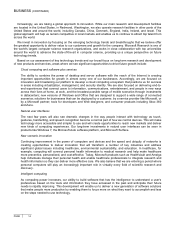Microsoft 2009 Annual Report Download - page 23
Download and view the complete annual report
Please find page 23 of the 2009 Microsoft annual report below. You can navigate through the pages in the report by either clicking on the pages listed below, or by using the keyword search tool below to find specific information within the annual report.
PAGE 23
Microsoft Business Division
(In millions, except percentages) 2009 2008 2007
Percentage
Change 2009
Versus 2008
Percentage
Change 2008
Versus 2007
Revenue $18,894 $18,929 $16,476 –% 15%
Operating income $12,141 $12,369 $10,838 (2)% 14%
Microsoft Business Division (“MBD”) offerings consist of the Microsoft Office system and Microsoft Dynamics
business solutions. Microsoft Office system products are designed to increase personal, team, and organization
productivity through a range of programs, services, and software solutions. Growth of revenue from the Microsoft
Office system offerings, which generate over 90% of MBD revenue, depends on our ability to add value to the core
Office product set and to continue to expand our product offerings in other information worker areas such as content
management, enterprise search, collaboration, unified communications, and business intelligence. Microsoft
Dynamics products provide business solutions for financial management, customer relationship management,
supply chain management, and analytics applications for small and mid-size businesses, large organizations, and
divisions of global enterprises. We evaluate our results based upon the nature of the end user in two primary parts:
business revenue, which includes Microsoft Office system revenue generated through volume licensing agreements
and Microsoft Dynamics revenue; and consumer revenue, which includes revenue from retail packaged product
sales and OEM revenue.
Fiscal year 2009 compared with fiscal year 2008
MBD revenue was flat reflecting decreased consumer revenue offset by increased business revenue, and included a
favorable impact from foreign currency exchange rates of $378 million or two percentage points. Consumer revenue
decreased $525 million or 14%, primarily as a result of PC market weakness, a shift to lower-priced products, and
pricing promotions on the 2007 Microsoft Office system. Business revenue increased $490 million or 3%, primarily
reflecting growth in volume licensing agreement revenue and included a 7% decrease in Microsoft Dynamics
customer billings. The growth in volume licensing agreement revenue primarily reflects recognition of deferred
revenue from previously signed agreements.
MBD operating income decreased reflecting increased cost of revenue and research and development expenses,
partially offset by decreased sales and marketing expenses. Cost of revenue increased $135 million or 14% primarily
driven by expenses associated with Fast Search & Transfer ASA (“FAST”) which we acquired in April 2008, as well
as online services infrastructure costs. Research and development expenses increased $119 million or 8%, primarily
driven by an increase in headcount-related expenses associated with FAST. Sales and marketing expenses
decreased $90 million or 2%, primarily driven by a decrease in corporate marketing activities and headcount-related
costs associated with our corporate sales force.
Fiscal year 2008 compared with fiscal year 2007
MBD revenue increased reflecting growth in licensing of the 2007 Microsoft Office system and included a favorable
impact from foreign currency exchange rates of $724 million or four percentage points. Business revenue increased
$2.6 billion or 21%, primarily as a result of growth in volume licensing agreement revenue and strong transactional
license sales to businesses. The increase in business revenue also included a 21% increase in Microsoft Dynamics
customer billings. Consumer revenue decreased $131 million or 3%, reflecting the consumer launch of the 2007
Microsoft Office system in fiscal year 2007.
MBD operating income increased reflecting growth in revenue, partially offset by increased sales and marketing
expenses, research and development expenses, and cost of revenue. Sales and marketing expenses increased
$446 million or 13%, reflecting increased expenses associated with our corporate sales force. Research and
development expenses increased $229 million or 18%, primarily driven by an increase in headcount-related
expenses and a $35 million in-process research and development expense related to the acquisition of FAST. Cost
of revenue increased $214 million or 27%, primarily driven by an increase in online services infrastructure costs and
product costs related to retail packaged product sales. Headcount-related expenses increased 10%, driven by an
increase in headcount from the prior year-end.
























